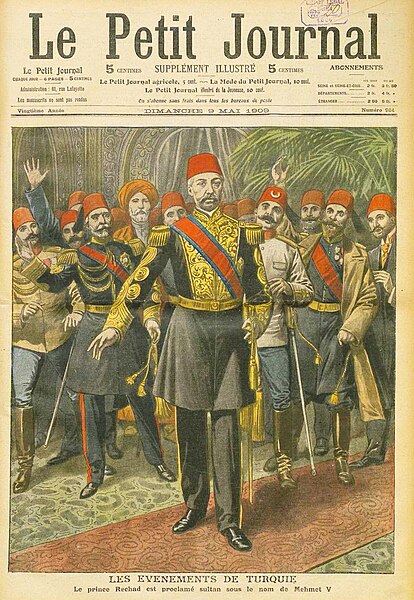Mehmed V Reşâd was the penultimate sultan of the Ottoman Empire from 1909 to 1918. Mehmed V reigned as a constitutional monarch, interfering little when it came to government affairs, though the constitution was held with little regard by his ministries. The first half of his reign was marked by contentious politicking between factions of the Young Turks, and the second half by war and domination of the Committee of Union and Progress and the Three Pashas.
Photograph by Carl Pietzner, June 1915
Padişah Reşad's Cülûs ceremony.
Le Petit Journal, Mehmed V is proclaimed Sultan in 1909.
Mehmed V arrives in Selânik (Thessaloniki), Ottoman Empire, 1909.
Committee of Union and Progress
The Committee of Union and Progress, refers to several revolutionary groups and a political party active between 1889 and 1926 in the Ottoman Empire and the Republic of Turkey. The foremost faction of the Young Turks, the CUP instigated the 1908 Young Turk Revolution, which ended absolute monarchy and began the Second Constitutional Era. After an ideological transformation, from 1913 to 1918, the CUP ruled the empire as a dictatorship and committed genocides against the Armenian, Greek, and Assyrian peoples as part of a broader policy of ethnic erasure during the late Ottoman period. The CUP and its members have often been referred to as Young Turks, although the movement produced other political parties as well. Within the Ottoman Empire its members were known as İttihadcılar ('Unionists') or Komiteciler ('Committeemen').
Committee of Union and Progress
Members of the Young Turks: İshak Sükuti, Serâceddin Bey, Tunalı Hilmi, Âkil Muhtar, Mithat Şükrü, Emin Bey, Lutfi Bey, Doctor Şefik, Nûri Ahmed, Doctor Reshid and Celal Münif
Ahmed Rıza, prominent early member of the CUP
Members of the Central Committee of the CUP proclaiming the Second Constitutional Era. Hafız Hakkı, Hafız İbrahim Hakkı, Talât, Enver, Rıza, Hüseyin Kazım (Kadri), Unknown, Midhat Şükrü (Bleda), Hayri.








